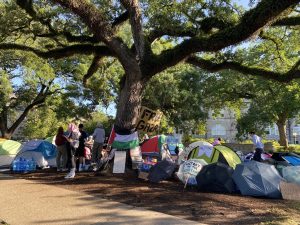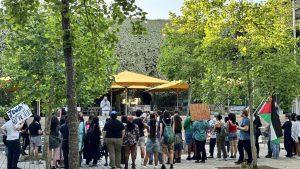Content warning: This article contains graphic descriptions of violence and death.

The first Nazi Germany concentration camp was established on March 22, 1933. While its initial use was for political prisoners, it was the model by which Nazis built the centralized system of death camps.
Over six million Jews and five million others would be brutally murdered over the course of the Holocaust, mostly in these camps. The first time the word “genocide” was used was to describe the atrocities of the Holocaust.
According to the Holocaust Museum Houston,“From 1944 to 1945, Allied troops advanced into Nazi territory and began to discover and liberate concentration camps. Liberators came from different countries, including the United States, the Soviet Union, Britain and Canada, and provided assistance and relief to Jewish prisoners.”
On April 17, Tulane students and faculty had the chance to hear from one of those liberators at Steven and Jan Paul Hall.
Bill Kongable was a member of the 354th Infantry Regiment Anti-Tank Company of the 89th Infantry Division, in General George S. Patton’s 3rd Army.
Kongable was born in Hominy, Osage County, Oklahoma. He was drafted days after graduating high school, at the age of 19. By the end of his senior year, a class of 36 boys dropped to 12. “After the attack on Pearl Harbor, the whole town changed, the whole state changed … everybody was so mad,” he said.
His regiment was the first to liberate a concentration camp. Ohrdruf was a labor concentration camp, not a death camp like Auschwitz. However, prisoners within these camps were often worked to death. The 354th Regiment came across Ohrdruf on April 28, 1945. Kongable said a mass grave he saw at this camp “was a long open pit with about three thousand naked skeletons and bones … there were bodies of prisoners who’d been executed with a bullet to the head.”
Then-General Dwight D. Eisenhower made sure to see Ohrdruf. “Get it all on record now. Get the films, get the witnesses, because somewhere down the road of history some bastard will get up and say that this never happened,” Eisenhower said.
Kongable’s regiment continued to uncover the horrific treatment of these prisoners. “Inside the camp there was a large shed with naked, emaciated bodies stacked up like logs against the wall in a woodshed,” he said.
“The memory, it never goes away. You just can’t understand how a nation can be so cruel,” Kongable said.
It took Kongable a long time to discuss his experiences publicly. He was in his 70s when he first spoke about liberating Ohrdruf.
Kongable also discussed the events of Oct. 7, the deadliest attack on Jewish people since the Holocaust.
“I knew for years Hamas’s only objective was to destroy Israel,” he said, “when they made that attack, and I heard the description of their techniques and their actions … it made me mad.”
When discussing American politics and an increase in political extremism, Kongable said “There are people who want to throw out the constitution, destroy our democracy and establish a one-party dictatorship. It’s possible the Holocaust could happen here, if the wrong people get in,” Kongable said.
Kongable referenced Project 2025, a presidential transition plan released by the Heritage Foundation that has garnered support among notable Trump allies, including former campaign manager and advisor Steve Bannnon. Project 2025 aims to fire roughly 50,000 civil servants — government workers who are not political appointees — and replace them with political loyalists to Trump and his potential administration.
The last question asked to Kongable was what his wish would be for our generation. His response: “that Trump doesn’t get elected.”






















Leave a Comment